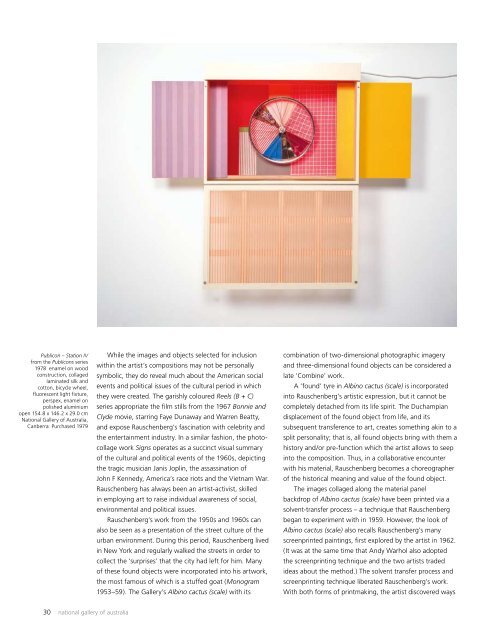Art Ew - National Gallery of Australia
Art Ew - National Gallery of Australia
Art Ew - National Gallery of Australia
You also want an ePaper? Increase the reach of your titles
YUMPU automatically turns print PDFs into web optimized ePapers that Google loves.
Publicon – Station IV<br />
from the Publicons series<br />
1978 enamel on wood<br />
construction, collaged<br />
laminated silk and<br />
cotton, bicycle wheel,<br />
fluorescent light fixture,<br />
perspex, enamel on<br />
polished aluminium<br />
open 154.8 x 146.2 x 29.0 cm<br />
<strong>National</strong> <strong>Gallery</strong> <strong>of</strong> <strong>Australia</strong>,<br />
Canberra Purchased 1979<br />
30 national gallery <strong>of</strong> australia<br />
While the images and objects selected for inclusion<br />
within the artist’s compositions may not be personally<br />
symbolic, they do reveal much about the American social<br />
events and political issues <strong>of</strong> the cultural period in which<br />
they were created. The garishly coloured Reels (B + C)<br />
series appropriate the film stills from the 1967 Bonnie and<br />
Clyde movie, starring Faye Dunaway and Warren Beatty,<br />
and expose Rauschenberg’s fascination with celebrity and<br />
the entertainment industry. In a similar fashion, the photocollage<br />
work Signs operates as a succinct visual summary<br />
<strong>of</strong> the cultural and political events <strong>of</strong> the 1960s, depicting<br />
the tragic musician Janis Joplin, the assassination <strong>of</strong><br />
John F Kennedy, America’s race riots and the Vietnam War.<br />
Rauschenberg has always been an artist-activist, skilled<br />
in employing art to raise individual awareness <strong>of</strong> social,<br />
environmental and political issues.<br />
Rauschenberg’s work from the 1950s and 1960s can<br />
also be seen as a presentation <strong>of</strong> the street culture <strong>of</strong> the<br />
urban environment. During this period, Rauschenberg lived<br />
in New York and regularly walked the streets in order to<br />
collect the ‘surprises’ that the city had left for him. Many<br />
<strong>of</strong> these found objects were incorporated into his artwork,<br />
the most famous <strong>of</strong> which is a stuffed goat (Monogram<br />
1953–59). The <strong>Gallery</strong>’s Albino cactus (scale) with its<br />
combination <strong>of</strong> two-dimensional photographic imagery<br />
and three-dimensional found objects can be considered a<br />
late ‘Combine’ work.<br />
A ‘found’ tyre in Albino cactus (scale) is incorporated<br />
into Rauschenberg’s artistic expression, but it cannot be<br />
completely detached from its life spirit. The Duchampian<br />
displacement <strong>of</strong> the found object from life, and its<br />
subsequent transference to art, creates something akin to a<br />
split personality; that is, all found objects bring with them a<br />
history and/or pre-function which the artist allows to seep<br />
into the composition. Thus, in a collaborative encounter<br />
with his material, Rauschenberg becomes a choreographer<br />
<strong>of</strong> the historical meaning and value <strong>of</strong> the found object.<br />
The images collaged along the material panel<br />
backdrop <strong>of</strong> Albino cactus (scale) have been printed via a<br />
solvent-transfer process – a technique that Rauschenberg<br />
began to experiment with in 1959. However, the look <strong>of</strong><br />
Albino cactus (scale) also recalls Rauschenberg’s many<br />
screenprinted paintings, first explored by the artist in 1962.<br />
(It was at the same time that Andy Warhol also adopted<br />
the screenprinting technique and the two artists traded<br />
ideas about the method.) The solvent transfer process and<br />
screenprinting technique liberated Rauschenberg’s work.<br />
With both forms <strong>of</strong> printmaking, the artist discovered ways

















